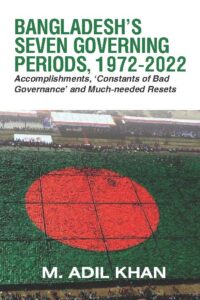Author: M. Adil Khan, Publisher South Asia Journal ISBN 978-0-9995649-2-9 Hardcover US$ 28.00 BDT 750 185 pages To order the book, please email info@southasiajournal.net
By Arnold Zeitlin 6 November 2023
Adil Khan, with a lengthy international background as a specialist in country development, has produced a handy guide to Bangladesh’s political history, which he has divided into seven periods, ranging from 1972 and Sheikh Mujibur Rahman’s rule and demise to 2022 and the current rule of Mujib’ daughter, Sheikh Hasina Wazed.
He writes respectfully about Mujib, referring to him repeatedly and majestically as Bangabandhu Sheikh Mujibur Rahman as if he feared readers might forget his role as father of the nation. To Khan’s credit, he concludes his book by declaring, without mentioning any names, “lionization of national heroes at the cost of others is not just disgraceful, it is harmful…leaders also make mistakes and thus, along with their accomplishments, it is also important that their mistakes are acknowledged…No leader should ever be placed on a pedestal and given a god-like status….”
That may seem to be so much for Bangabandhu. But Khan also condemns Tarique Rahman, the son of Begum Zia and Ziaur Rahman, for lionizing his father and introducing “a new and hitherto unknown political culture…(that) has since become uglier by the day….”
In discussing Mujib’s imposition in 1975 of a one-party state, BAKSAL, Khan writes that the August 15 coup that led to the murder of Mujib and most of his family is the “darkest chapter in the history of Bangladesh” and goes on to note that “given the rising frustrations and resentments against the authoritarian behavior of the government and its use of brute force to suppress dissent, desperation for change intensified and left with no constitutional means to initiate change, the change did come eventually brutally and tragically…”
Khan goes on to divide the rest of Bangladesh’s political history this way:
* Anarchy from August to December 1975;
* A Great Reset, Ziaur Rahman’s rule from January 1976 to May 1981;
* Development and Deceit, Ershad’s rule from 1982 to 1990;
* Return of parliamentary democracy, as Begum Khaleda Zia and Sheikh Hasina alternate terms from 1991 to 2007;
* Army-backed caretaker government 2007 to December 2008;
* Sheikh Hasina ruled from 2009 to the present.
Omitted from his list is the period from April 1971 to January 1992, when a weak government in exile existed in Calcutta. It did not rule, but it contained the fissures to bedevil the country. Had the government continued, with Tajuddin Ahmed as prime minister and Mujib as a lofty but removed from governing president, there is no telling what Bangladesh’s early political history might have been.
With Mujib gone, the rule of Khandoker Mushtaque Ahmed as president lasted only a few months before it fell to another coup and countercoup but, according to Khan, was transformational because it steered Bangladesh from secularism and socialism to an Islamic state with a free market economy. Khan also notes that assertions that Mushtaque played a role in the coup that killed Mujib remain unproven.
Ziaur Rahman, ousted as army chief and jailed under one coup and reinstated under another, rose to power and, according to Khan, introduced the resets and reforms “that transformed Bangladesh from its collapsing state to an economically advancing and administratively consolidated, forward-looking nation.”
But Zia, like Mujib, made missteps and was murdered in his bed. Khan offers this assessment of Zia: “It is difficult to imagine whether anyone other than Ziaur Rahman…could have salvaged the nation, which at the time was on the verge of collapse.”
Khan has few kind words for Zia’s military successor, Lt. General Hussain Muhammed Ershad. Noting Ershad’s fondness for pretty women,” the author concludes: “Despite several important and positive contributions to advance Bangladesh economically, Ershad’s character, which was anything but open and above board, tarnished his image and seriously dented his credibility. Ershad was known to be corrupt personally, and as a result, corruption spread throughout the government.”
The writer is unhappy with the state of Bangladesh under Sheikh Hasina.
“The governing period 2009-present is unique,” he writes,”…for its contradictions…during this period Bangladesh achieved the highest GDP growth…and during this period poverty has been reduced significantly and yet at the same time, the period has experienced significant governance and moral backslides that have curbed political freedom, promoted hate politics and divided the nation, and in the process has dented democracy, promoted authoritarianism and corruption and more importantly, this period’s aggressive politicization of the public institutions including the education institutions have severely curtailed the capacity of these institutions to efficiently (function)…with the result that the society face the danger of collapse and undo the gains it made.”
Khan devotes his final chapter to suggestions to set Bangladesh on a proper path. They include restoring democracy and the rule of law, controlling corruption, restoring decency in all spheres of life, rebuilding Bangladeshi nationhood, rationalizing the public sector financial management system, and promoting “a vibrant market economy which is people-centric and not exploitative; recalibrating Bangladesh-Indian relations.
Concerning the latter, Khan writes, “it is evident that…thanks to the ruling Awami League’s dependence on India…to stay in power….have compromised the capacity of Bangladesh to pursue its policies…independently….”
As for accomplishing this reset, Khan writes, “time is ripe for the Bangladeshis to consolidate their gains and vanquish the mistakes and the good news is….that Bangladeshis have this unique capacity to take in a lot, but a time comes when they stand up and confront the predators and take upon themselves the task of remedying the wrongs and usher in a new beginning. That time has come.”
We will see if that time has come.

